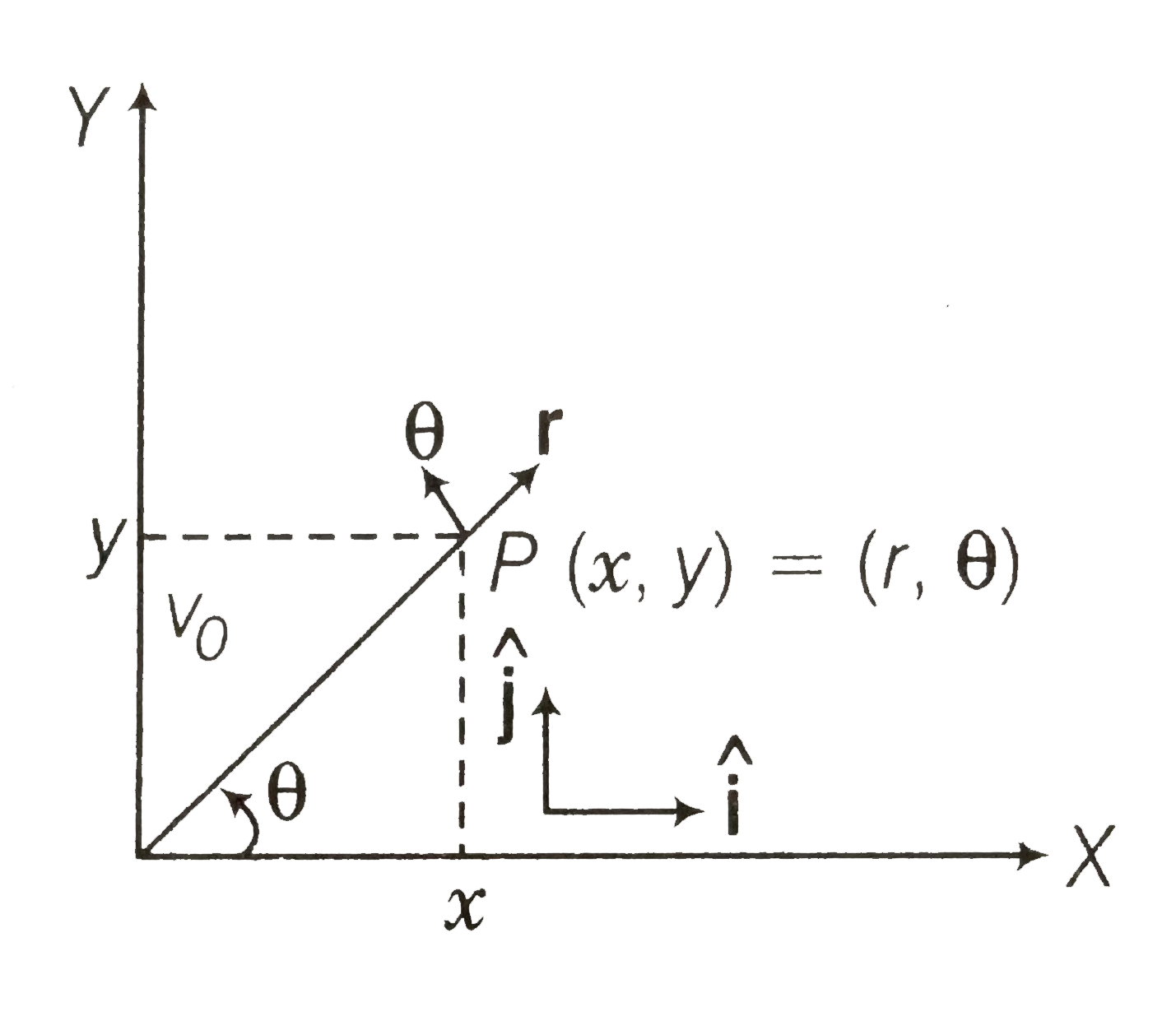Motion in two dimensions, in a plane can be studied by expressing position, velocity and acceleration as vectors in cartesian coordinates A=Axˆi+Ayˆj, where ˆi and ˆj are unit vector along x and y-directions, respectively and Ax and Ay are corresponding components of A. Motion can also be studied by expressing vectors in circular polar coordinates as A=Arˆr+Aθˆθ, where ˆr=rr=cosθˆi+sinθˆj and ˆθ=−sinθˆi+cosθˆj are unit vectors along direction in which r and θ are increasing.
(a) Express ˆi and ˆj in terms of ˆr and ˆθ.
(b) Show that both ˆr and ˆθ are unit vectors and are perpendicular to each other.
(c) Show that ddt(ˆr)=ωˆθ, where ω=dθdt and ddt(ˆθ)=−θˆr.
(d) For a particle moving along a spiral given by r=aθˆr, where a = 1 (unit), find dimensions of a .
(e) Find velocity and acceleration in polar vector representation for particle moving along spiral described in (d) above.

(a) ˆr=cosθ+sinθjˆj
ˆθ=−sinθˆI+cosaθˆj ….(i)
Multipluing (i) by sinθ and (ii) with cosθ and adding, we get ….(ii)
ˆe=−sinθ+ˆθcoshtη=(sin2θ+cos∘θ)ˆj=ˆj or hat r sin theta + hat theta cos theta = hat j....(iii)<br>Mjt–iply∈g(i)bycosθand(ii)bysinθand⊂tract∈g,we≥t ltbr> ( hat r cos theta - hat theta sin theta ) = hat i....(iv)<br>(b) hat i. hat theta = ( hat i + sin theta hat j). (- sin theta hat i + cos theta hat j)<br>(1)(1) cos theta =- cos theta sin theta + sin theat cos theta =0= cos 90^@or theta = 90^@<br>(c)ddrˆr)=ddrcosθˆi+sinθˆj)=−sinθdθdtˆicostehtadθdtˆi+cosθdthηdtˆj=ω[−sinˆi+cosθˆj]=ωˆiθ ltBrgt (d) →r=αθˆr or |→r|=αθ or alpha = (|vec r|)/(theta)<br>Dimensionsof alpha L/1 = L = [M^0 L^1 T^0 ]<Br>(E)Given, alpha =1 unit,omabove,wehave vec r = theta hat r = theta [ cos theta hat i + sin theta hat j]<br>velocity, vec r = (d vec r)/(dt) = ( d theta )/( dt) vec r + theta [ - sin theta hat i + cos theta hat j] ( d theta)/(dt) vec r + theta hat i theta omega[∴dθdt=moega]
ωˆr+ωˆθ
Accelration, →a=ddt[ωθˆθ]=ddt[dθdt×(θˆθ)]=d2θdt2ˆr+dθdtdˆrdt+d2θdt2×dθdtddt(θˆθ)
=d2θst∘ˆr+ωddt[cosθˆi+sinθˆj]+(d2θ).dt2θˆθ+ωddt(θˆθ)
=d2theadt2ˆrω[−sinhηˆi+cisθˆj]dθdt+d2θdt2θˆθ+ω[dtehtadtˆθ+θ)dˆθ)dt]
=d2θdt2ˆr+ω2ˆθ+d2θdt2×θˆθ+ω2ˆθ+ω2θ(−ˆe) [∴dˆθdt=−ωˆr]
=d2θdt2−ω2θ)ˆr+(2ω2+d2θdt2θ)ˆθ.
Topper's Solved these Questions
- KINEMATICSBook:PRADEEPChapter:KINEMATICSExercise:Advanced Problems
Explore 20 Videos
- KINEMATICSBook:PRADEEPChapter:KINEMATICSExercise:NCRT Exercises
Explore 22 Videos
- KINEMATICSBook:PRADEEPChapter:KINEMATICSExercise:5 Long answer (NCERT)
Explore 4 Videos
- GRAVIATIONBook:PRADEEPChapter:GRAVIATIONExercise:Assertion-Reason Type Questions
Explore 19 Videos
- LAWS OF MOTIONBook:PRADEEPChapter:LAWS OF MOTIONExercise:Assertion- Reason Type Questions
Explore 17 Videos
Similar Questions
Motion in two dimensions, in a plane can be studied by expressing position, velocity and acceleration as vectors in cartesian coordinates A=Axˆi+Ayˆj, where ˆi and ˆj are unit vector along x and y-directions, respectively and Ax and Ay are corresponding components of A. Motion can also be studied by expressing vectors in circular polar coordinates as A=Arˆr+Aθˆθ, where ˆr=rr=cosθˆi+sinθˆj and ˆθ=−sinθˆi+cosθˆj are unit vectors along direction in which r and θ are increasing.
(a) Express ˆi and ˆj in terms of ˆr and ˆθ.
(b) Show that both ˆr and ˆθ are unit vectors and are perpendicular to each other.
(c) Show that ddt(ˆr)=ωˆθ, where ω=dθdt and ddt(ˆθ)=−θˆr.
(d) For a particle moving along a spiral given by r=aθˆr, where a = 1 (unit), find dimensions of a .
(e) Find velocity and acceleration in polar vector representation for particle moving along spiral described in (d) above.

View SolutionThe vector (ˆi+ˆj) is a unit vector.
View Solution
Knowledge Check
The angle which the vector →A=2ˆi+3ˆj makes with the y-axis, where ˆi and ˆj are unit vectors along x- and y-axis, respectively, is
Acos−1(3/5)Bcos−1(2/3)Ctan^(-1)(2//3)Dsin−1(2/3)The unit vector along ˆi+ˆj is
AˆkBˆi+ˆjCˆi+ˆj√2Dˆi+ˆj2If ˆi,ˆj,ˆk are the unit vectors and mutually perpendicular, then [ˆiˆjˆk]=
A0B−1C1D2
If ˆiandˆj are unit vectors along X- and Y-axis respectively, then what is the magnitude and direction of ˆi+ˆjandˆi−ˆj ?
View SolutionThe angle θ between the vector →p=ˆi+ˆj+ˆk and unit vector along X-axis is
View SolutionGiven, two vectors are ˆi−ˆjandˆi+2ˆj, the unit vector coplanar with the two vectors and perpendicular to first is
View SolutionIf ˆi,ˆjandˆk are unit vectors along x,y and z-axis respectively, the angle θ between the vector ˆi+ˆj+ˆk and vectorˆj is given by
View SolutionVectors which is perpendicular to (acosθˆi+bsinθˆj) is
View Solution

